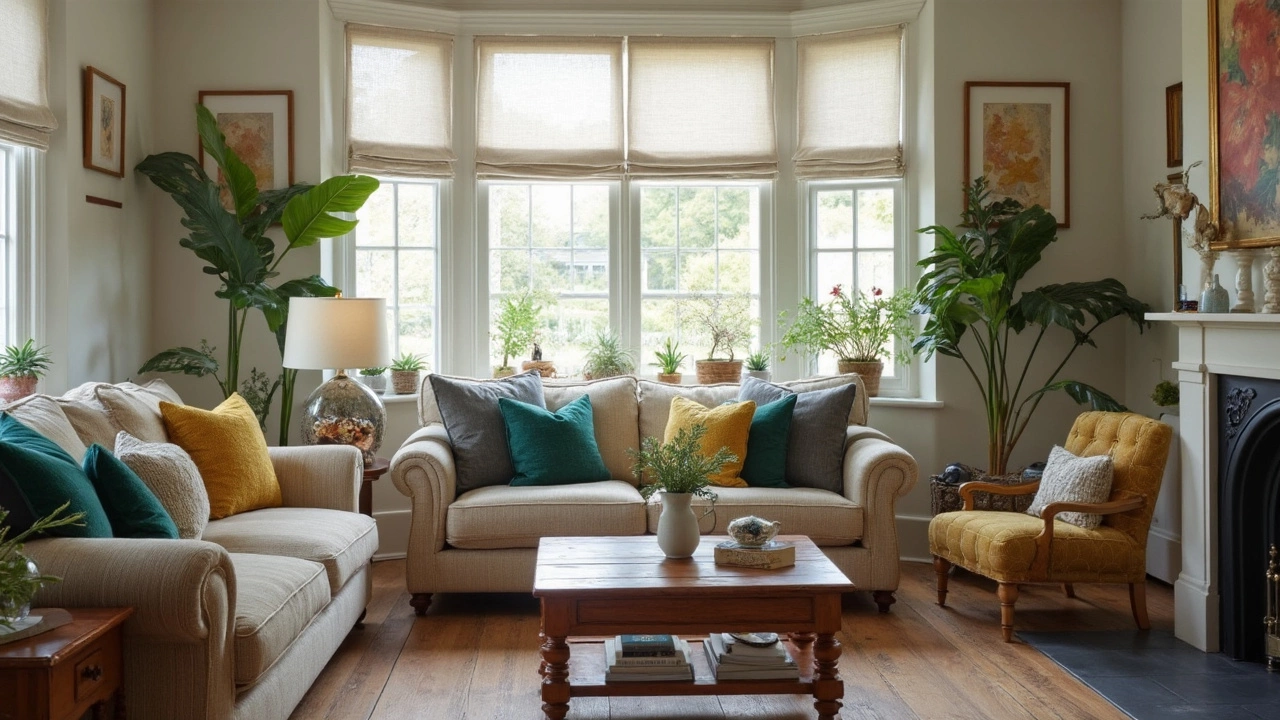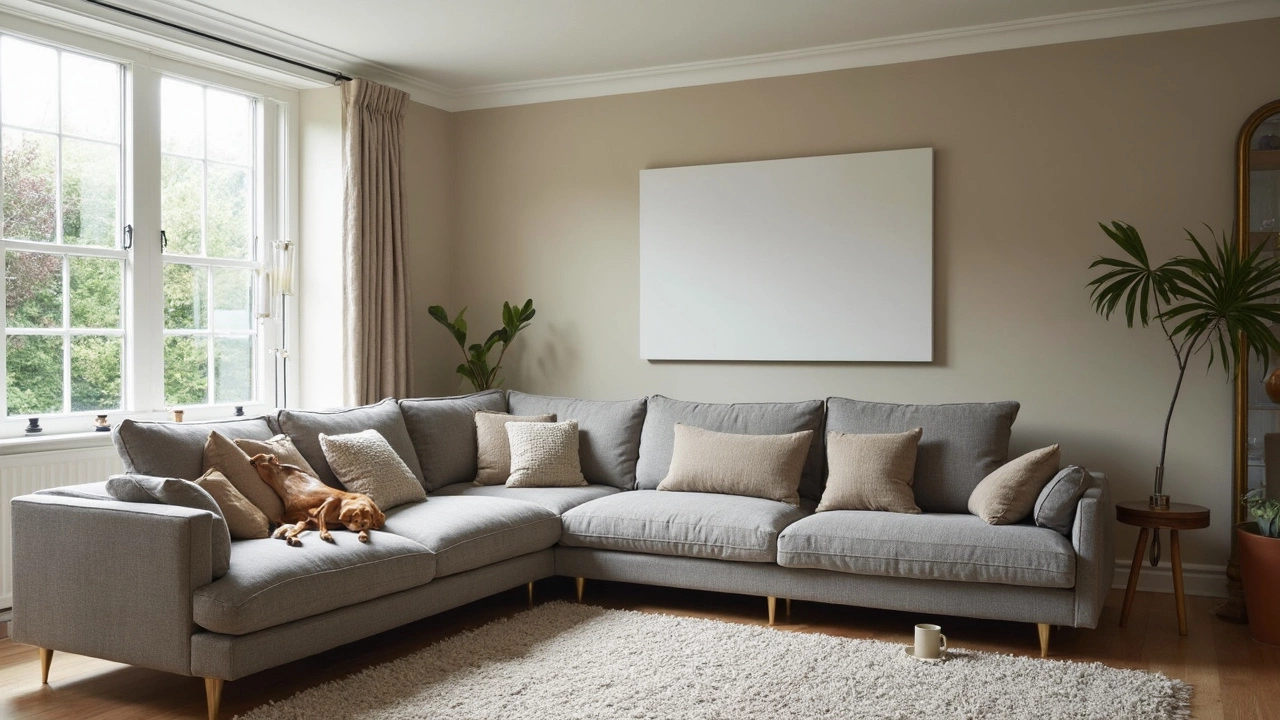Best Colour for Sofa: A Practical Guide for Picking Sofa Cushion Shades

Ever notice how a sofa's colour can totally change the vibe of your living room? Picking the best colour for your sofa cushions isn't just about what looks cool online. It's about real life—spills, sunlight, pets, and matching your actual stuff at home. Everyone's got opinions, but most folks just want something that looks good, lasts, and doesn't make them panic when there's a coffee mishap.
Let’s face it, the wrong sofa colour is hard to ignore. Some shades show every little mark, while others can make your whole room feel either too dark or like you live in a dentist’s office. The trick is finding that sweet spot—something practical, good-looking, and flexible enough to roll with your style changes. And yeah, there’s actually a bit of science behind how colour affects mood and space. We’ll get into that, sharing tips for picking sofa cushion colours you won’t regret in a year.
- Why Colour Choice Matters for Sofas
- Popular Sofa Colours: Pros and Cons
- Matching Sofa Cushions to Room Vibes
- Smart Tips for Colour Confidence
Why Colour Choice Matters for Sofas
Choosing the right sofa colour can make the difference between loving your living room and wanting to rearrange the whole house. It's not just a style thing—it's also about practicality, maintenance, and even how big or cozy your space feels. When you look at surveys from big furniture retailers, over 60% of people say furniture colour is their top factor when buying a sofa, even more than price or brand. That should tell you how much this choice sticks with you every day.
Light colours, like beige or cream, create an open, airy vibe and work great if your room is small or doesn't get much sunlight. But they show stains and dirt way faster, especially if you've got kids or a pet that sheds. On the flip side, darker shades—think navy or charcoal—hide spills and smudges, but they can make a tiny apartment look even smaller if you're not careful. Colour even has a psychological effect. For example, blue cushions tend to feel calming and trust-worthy, while yellow or orange can make things feel warmer and more energetic.
Sofa colour isn't only about matching the curtains, either. It's got longevity. If you pick a trendy colour you’re bored with next year (I'm looking at you, millennial pink), it's not as easy to swap as a throw pillow. Neutral colours won’t date as fast and are easier to decorate around when your taste changes.
- If you host a lot, mid-tone greys and browns tend to stay looking fresh thanks to how well they hide marks.
- If you love bold colours but worry about commitment, go with neutral sofas and add colourful cushions as a low-risk splash.
- If sunlight hits your sofa all day, look out for colours that won’t show fading as quickly—darker shades tend to age better for this.
Check out this quick table comparing the practical effects of common colours for sofa cushions:
| Colour | Shows Stains | Room Impact | Fades in Sun |
|---|---|---|---|
| Beige/Cream | High | Makes room bigger | Low |
| Grey | Low | Neutral, matches most styles | Medium |
| Navy/Blue | Low | Feels calm, may look smaller | Medium |
| Green | Medium | Fresh, works with wood | Medium |
| Yellow/Orange | Medium | Warms up the space | High |
| Charcoal/Black | Very Low | Adds drama, hides marks | High |
The main thing: sofa colour sticks with you. Picking smart isn’t just about today’s Instagram trends—think about who uses your sofa, how much chaos it’ll face, and how you want to feel in your space every day.
Popular Sofa Colours: Pros and Cons
When it comes to picking a sofa, the colour you land on is going to set the tone for your entire living room. Some colours look bold in a showroom but can make your space feel cramped or show every fingerprint once the sofa's actually at home. Let's lay out the facts about the most common choices.
- Grey: Everyone swears by grey. It’s the go-to, for a reason—it hides dirt, fades slowly, and plays nice with most cushion colours. Lighter greys are great for small rooms, but they can show stains from pets or red wine. Darker greys are safer if your house is busy.
- Beige and Taupe: These colours don’t fight with your curtains or rugs, so your room stays calm. They’re solid for homes with kids, but after a while, they can feel a bit bland if you don’t jazz things up with bright or patterned sofa cushions.
- Blue: From soft sky blue to navy, blue couches look stylish without being in-your-face. Navy especially hides wear and tear, but lighter blues can show denim stains from jeans and dirt more easily. Blue’s also known for making rooms feel chill and welcoming.
- Green: Sage and olive are having a moment, probably because they bring a bit of nature inside and match with wood or plants. Deeper greens hide marks better. Lime or bright greens are trickier—cool for a teen’s hangout, less so for main rooms.
- Black: Looks sleek at first but shows lint, dust, and pet hair almost instantly. It can make a room feel smaller, especially if there’s not much sunlight. If you want that modern vibe, just know you’ll need to vacuum it often.
- White or Cream: Sure, they look fancy, but unless you’re living alone and never eat on the sofa, these colours are a magnet for stains. Even water rings can turn into a mark. Some newer performance fabrics help, but still, high maintenance.
Here’s a quick breakdown on how these colours actually perform day-to-day:
| Colour | Hides Stains | Low Maintenance | Room Size Effect | Trendy (2025) |
|---|---|---|---|---|
| Grey | Yes | Yes | Makes room bigger | Yes |
| Beige/Taupe | Sometimes | Yes | Neutral impact | Yes |
| Blue | Navy: Yes Lighter: No |
Navy: Yes Lighter: No |
Makes room calm | Yes |
| Green | Sage/Olive: Yes Bright: No |
Sage/Olive: Yes Bright: No |
Natural feel | Yes |
| Black | No | No | Can shrink space | No |
| White/Cream | No | No | Makes room brighter | No |
Don’t just wonder if the colour is trendy. Think about your lifestyle, lighting, and whether cleaning is going to annoy you every week. A sofa is a long-term thing. Pick a colour you’ll still like after the next reel of trend cycles passes.

Matching Sofa Cushions to Room Vibes
Nailing the right sofa cushion colour is about more than just copying ideas from magazines. It’s about making your place feel right for you. The colour you pick can seriously shift the whole mood of your living room. If you’re feeling unsure, keep this in mind: your sofa is usually the first thing people notice when they walk in, so it either sets a cozy tone or stands out in a way you might not want.
Let’s get real—light colours like beige, cream, or pale grey can make small spaces feel bigger. They bounce light around the room and look fresh. But here’s the catch: they’re magnets for stains, especially if you have kids or pets. Darker shades—think navy, charcoal, or forest green—are lifesavers when it comes to hiding messes. If your room doesn’t get a ton of sun, though, these can make it feel smaller or gloomier.
Want your sofa to pop? Go bold with deep reds, rich blues, or mustard yellow cushions. Just remember, loud colours draw attention fast, so use them in rooms with neutral walls. “Accent cushions are like an instant home update for people who don’t want to buy a whole new couch,” says interior designer Angela Harris.
"The right cushion colour can make mismatched furniture tie together or help a boring room stand out."
One trick I’ve learned from helping friends redecorate: use the 60-30-10 rule. Make 60% of the room’s colour a main neutral (like your walls, rug, or the bulk of your sofa), 30% a secondary colour (curtains or accent chairs), and 10% something bold (that’s where your sofa cushions come in handy). This balance keeps things from looking too wild or too matchy-matchy. Here’s a handy table to show how different cushion colours usually work in different living room vibes:
| Room Style | Cushion Colour Ideas | Best For |
|---|---|---|
| Scandinavian | White, light grey, pastel blue | Small, bright rooms |
| Boho | Terracotta, mustard, olive green | Warm, laid-back spaces |
| Modern | Charcoal, navy, black | Minimal, sleek setups |
| Traditional | Burgundy, olive, beige | Classic, timeless feel |
Test out different cushions before buying a ton. Grab a few pillowcases in your favourite colours and toss them on the couch—see what clicks with your other stuff and lighting. Remember, it’s easier (and way cheaper) to swap out cushions later than a whole sofa if you get it wrong.
Smart Tips for Colour Confidence
Choosing the right sofa colour feels intimidating, but there’s a method to the madness. The key? Don’t overthink it—focus on how your space actually gets used and what makes you feel comfortable, not just what you saw trending on Instagram last week. Let’s break down some proven tricks and facts so you don’t second-guess yourself every time you walk by your couch.
First off, consider the practical stuff. If your sofa sits in a high-traffic spot (think pets, kids, snack zones), darker and mid-tone colours like charcoal, navy, or mocha are your friends. They’re champs at hiding stains and daily wear. Lighter colours, like white or cream, look fresh but will show every spill. For most families, mid-tones split the difference—they don’t look too dark and they hide a ton of messes.
- Light colours like beige or pale grey make small rooms look bigger, thanks to how they reflect light.
- Darker shades add coziness but can make a small space feel even tighter if you’re not careful.
- Earthy tones—think taupe, olive, soft blue—are proven to help reduce stress, and they play well with most décor.
- Sofa colour determines the mood: blues and greens chill you out, while reds and oranges make a space feel lively.
- Love patterns? Patterned sofa cushions hide messes and wear better than true solids.
Here’s a quick look at how people in real homes feel about popular sofa shade choices. In a survey of 1,000 homeowners for 2024:
| Sofa Colour | % Who Chose It | Regret Rate |
|---|---|---|
| Grey | 39% | 7% |
| Beige/Tan | 22% | 14% |
| Navy | 13% | 4% |
| White/Cream | 10% | 25% |
| Bold Colour | 8% | 19% |
The numbers don’t lie—greys and navies are popular and have lower "regret rates." Whites and bold colours seem tempting but tend to lead to second thoughts down the road. If you want to play it safe but not boring, add boldness through cushions and throws instead of the main sofa base. Natasha loves swapping cushion covers every season; it keeps the living room fresh without the stress.
And here's the deal: test at home. Bring home fabric swatches and look at them in both daylight and at night. Colours can look wildly different depending on your room’s lighting. When you find a hue that matches your vibe and life, you’ll know you nailed it.


